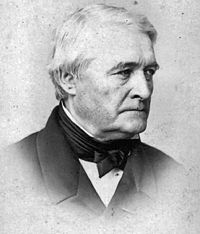
Claude Servais Mathias Pouillet
Encyclopedia

France
The French Republic , The French Republic , The French Republic , (commonly known as France , is a unitary semi-presidential republic in Western Europe with several overseas territories and islands located on other continents and in the Indian, Pacific, and Atlantic oceans. Metropolitan France...
physicist
Physicist
A physicist is a scientist who studies or practices physics. Physicists study a wide range of physical phenomena in many branches of physics spanning all length scales: from sub-atomic particles of which all ordinary matter is made to the behavior of the material Universe as a whole...
and a professor of physics at the Sorbonne and member of the French Academy of Science.
Pouillet was born in Cusance
Cusance
Cusance is a commune in the Doubs department in the Franche-Comté region in eastern France.-Population:...
, Doubs, France
France
The French Republic , The French Republic , The French Republic , (commonly known as France , is a unitary semi-presidential republic in Western Europe with several overseas territories and islands located on other continents and in the Indian, Pacific, and Atlantic oceans. Metropolitan France...
.
The famous Pouillet effect
Pouillet effect
In physics, the term Pouillet effect refers to an exothermic reaction that takes place when a liquid is added to a powder. It was first observed by Leslie in 1802 when dry sand was immersed in water. Claude Pouillet later described this phenomenon in 1822 when it came to be known as the Pouillet...
was named after the phenomenon that he published in 1822 on the heat produced by the wetting of dry sand.
He developed a pyrheliometer
Pyrheliometer
A pyrheliometer is an instrument for direct measurement of solar irradiance. Sunlight enters the instrument through awindow and is directed onto a thermopile which converts heat to an electrical signal that can be recorded. The signal voltage is converted via a formula to measure watts per square...
and made, between 1837 and 1838, the first quantitative measurements of Solar constant
Solar constant
The solar constant, a measure of flux density, is the amount of incoming solar electromagnetic radiation per unit area that would be incident on a plane perpendicular to the rays, at a distance of one astronomical unit...
. His estimates was 1228 W/m2, very close current estimate, 1367 W/m2. Using the wrong Dulong-Petit law he estimated the temperature
Temperature
Temperature is a physical property of matter that quantitatively expresses the common notions of hot and cold. Objects of low temperature are cold, while various degrees of higher temperatures are referred to as warm or hot...
of the Sun's surface to be around 1800 °C. This value was corrected in 1879 to 5430 °C by Jožef Stefan
Joseph Stefan
Joseph Stefan was a physicist, mathematician, and poet of Slovene mother tongue and Austrian citizenship.- Life and work :...
(1835–1893).
Pouillet works include:
- On atmospheric electricity, (London 1832),
- Éléments de physique expérimentale et de météorologie, (Paris 1856).
Svante Arrhenius (1896) cited a great deal of Pouillet's work.
Pouillet died in Paris
Paris
Paris is the capital and largest city in France, situated on the river Seine, in northern France, at the heart of the Île-de-France region...
, France.

